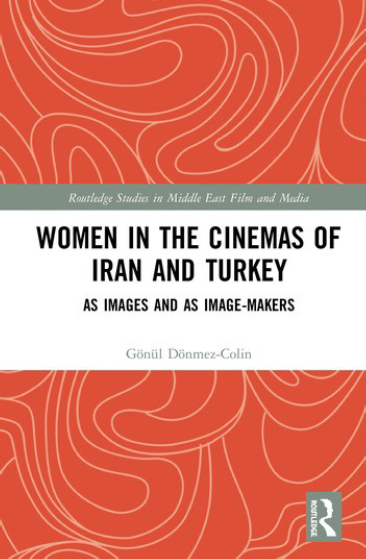Iran and Turkey have an ambivalent relationship as neighboring countries. Even though they resemble each other in many cultural and social aspects, there are also numerous political and religious differences. In her recent book, Gönül Dönmez-Colin deals with the reflections of these similarities and differences over the case of women in the cinemas of the two countries. As the subtitle suggests, her analysis is bilateral: She approaches women, both as identities represented and constructed through films (images) and as professional artists (image-makers). She revisits a theme from one of her previous books, Women, Islam and Cinema,1 but this time with a focus on Iran and Turkey only.
The author’s main goal is to analyze the presence and absence of women filmmakers and characters in the cinemas of these countries. By doing so, she demonstrates the ways in which cinema transcends borders of any form while having strong ties with certain cultures and traditions. She argues that the masculine hegemony regulating the field of cinema precluded the emergence of women as image-makers in Iran and Turkey. This is why women filmmakers emerged later than women characters in the films. Women’s representation in the films is also influenced by the hegemonic power plays over the woman’s body. Dönmez-Colin also asserts that there are certain differences in the ways women filmmakers of different generations speak about their creative work. While the older generation prefers an androgynous point of view that favors a sexless approach, the younger generation utilizes feminist consciousness.
In each chapter, Dönmez-Colin gives many examples both from Iran and Turkey, makes comparisons among the two, and occasionally allocates more space for the analysis of select films and select directors. She mainly relies on post-colonial and feminist literatures as the theoretical backbone of her analysis. She also benefits from many interviews she has conducted with women film-makers and actors over the years.
In the first chapter, she gives an account of women’s representation in films since the introduction of cinema in the two countries. In the second chapter, she switches to the second part of the book’s subtitle (image-makers) and gives an account of women’s limited presence as professional/creative artists. In chapter three, she focuses on traumatic events from the near histories of the two countries, the Islamic Revolution (1979) and the Iran-Iraq War (1980-88) for Iran, and the 12 September Military Coup (1980) for Turkey. Her goal is not to provide a complete account of post-traumatic films, rather she scrutinizes the repercussions of these traumatic events on women’s representation in films. Chapter four is about films with women characters that resist the norms of society in different ways. In this chapter, the author gives special attention to documentary filmmaking. Yet, she deals with the echoes of the Gezi demonstrations, a series of nation-wide protests against the government in Turkey in 2013. Chapter five is about the representation of sexual orientation, cross-dresser characters, and LGBTI identities. In the sixth chapter, the author focuses on border-crossing and transnational films and film-makers.
The last chapter is probably the most peripheral but interesting part of the book. In this chapter, with the ironic title of “His Films” Dönmez-Colin compares the cinemas of Abbas Kiarostami and Nuri Bilge Ceylan, two Palme d’Or winners from Iran and Turkey, who are criticized by feminist film critics with the claim of either not giving space to women characters or misrepresenting them in their films. Dönmez-Colin concludes her comparison of the two directors in favor of Kiarostami asserting that he “neither exalts nor ignores women,”2 and women characters in his films resist authority in different levels of the society. Ceylan, however, represents women in a traditional and conservative manner, and women characters in his films do not represent women of Turkey today.
The author has an impressive command of both countries' cinemas and related literature in English. Also, she seems to follow Turkish literature very closely, as she is a researcher originally from Turkey. Unfortunately, we cannot say the same for Persian literature which the author hardly cites, probably due to the language barrier. Although the author heavily benefits from the interviews she has conducted over the years with Iranian filmmakers, she can offer a stronger insight into Turkish cinema than Iranian cinema. I think it is a significant deficiency for a comparative study focusing on the cinemas of the two countries to not to make use of the Persian literature.
There were many similarities between narrative structures of Yeşilçam (Turkey’s old film industry between 1950s and 1980s) and Film Farsi (pre-revolution popular cinema of Iran). In fact, the two film industries had transnational links particularly during the 1970s, through re-productions, co-productions, and talent exchanges. The author provides very limited information and analysis on these links between Yeşilçam and Film Farsi. For instance, even though she allocates a specific chapter to border-crossing and transnationalism, and in other chapters she mentions the career of actor Puri Banai (Pouri Baneai) at length, the author does not speak about Banai’s Yeşilçam career. However, Banai performed in five Yeşilçam films in the 1970s and she had acquired a significant reputation in Turkey besides being one of the most popular women actors of pre-revolution Iranian cinema.
In the continuing lack of studies that focus on encounters, exchanges, and transnational connections among national cinemas, Dönmez-Colin’s book is a significant contribution to the literature. Besides being a good reading for any scholar or enthusiast who is interested in film studies, the book is also very suitable for graduate students, thanks to its well-organized structure which is helpful for reading the chapters separately.
Author Biography
Serkan Şavk is an assistant professor at Izmir University of Economics, Department of Cinema and Digital Media. He received his PhD from Hacettepe University in 2014. His research interests include history of cinema in Turkey, digital humanities and image-space connections in a historical perspective.

